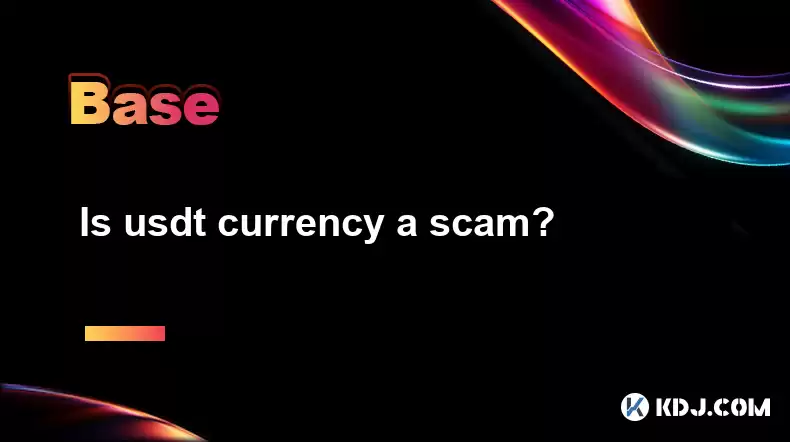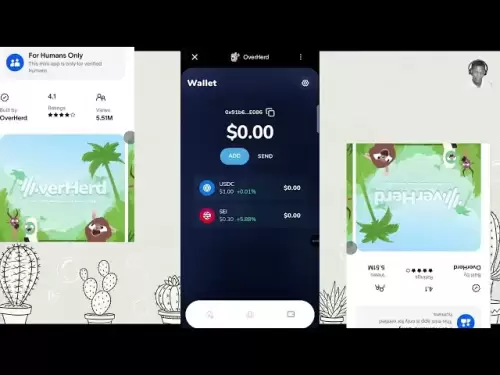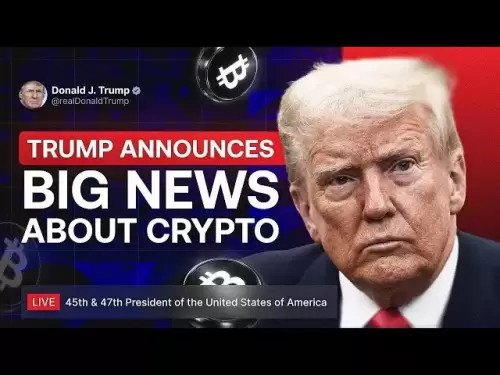-
 Bitcoin
Bitcoin $114200
0.00% -
 Ethereum
Ethereum $3637
0.56% -
 XRP
XRP $2.950
-2.01% -
 Tether USDt
Tether USDt $0.9999
0.02% -
 BNB
BNB $761.0
0.55% -
 Solana
Solana $164.1
-1.38% -
 USDC
USDC $0.9999
0.02% -
 TRON
TRON $0.3332
0.36% -
 Dogecoin
Dogecoin $0.2012
-0.52% -
 Cardano
Cardano $0.7261
-1.41% -
 Hyperliquid
Hyperliquid $37.62
-2.13% -
 Stellar
Stellar $0.3930
-2.65% -
 Sui
Sui $3.441
-0.16% -
 Bitcoin Cash
Bitcoin Cash $563.8
0.70% -
 Chainlink
Chainlink $16.50
0.09% -
 Hedera
Hedera $0.2424
-0.14% -
 Ethena USDe
Ethena USDe $1.001
0.01% -
 Avalanche
Avalanche $22.20
0.00% -
 Litecoin
Litecoin $118.0
-2.48% -
 UNUS SED LEO
UNUS SED LEO $8.991
0.12% -
 Toncoin
Toncoin $3.195
-3.87% -
 Shiba Inu
Shiba Inu $0.00001217
0.12% -
 Uniswap
Uniswap $9.674
-0.21% -
 Polkadot
Polkadot $3.633
1.00% -
 Monero
Monero $295.3
-0.82% -
 Dai
Dai $0.9999
0.00% -
 Bitget Token
Bitget Token $4.321
-0.41% -
 Cronos
Cronos $0.1392
0.73% -
 Pepe
Pepe $0.00001027
-0.89% -
 Aave
Aave $258.5
0.32%
Is usdt currency a scam?
Despite its stability, Tether, or USDT, has faced criticism due to alleged fraud and manipulation, affecting its credibility and trustworthiness.
Jan 23, 2025 at 10:07 pm

Key Points
- Understanding the Nature of USDT
- Examining the Backing and Stability of USDT
- Assessing the Credibility and Trustworthiness of Tether
- Reviewing the Regulatory Landscape and Oversight of USDT
- Analyzing the Potential Risks and Considerations Associated with USDT
Understanding the Nature of USDT
USDT, or Tether, is a cryptocurrency pegged to the value of the US dollar, meaning that its value aims to mimic that of the USD. It is designed to facilitate transactions in the cryptocurrency market and bridge the gap between cryptocurrencies and traditional fiat currencies.
Unlike other cryptocurrencies, USDT is a stablecoin, which means that its value is not determined by market forces but rather by its peg to the US dollar. This stability makes it an attractive option for investors seeking a safe haven during market volatility.
Examining the Backing and Stability of USDT
Tether has faced scrutiny regarding the backing and stability of USDT. The company has claimed that USDT is fully backed by US dollar reserves, but this has been disputed by some critics.
- Tether's Reserves: Tether's reserves consist of a combination of cash, cash equivalents, and other assets that supposedly match the amount of USDT in circulation. However, independent audits have raised concerns about the composition and liquidity of these reserves.
- Stablecoin Peg: The peg to the US dollar is maintained through algorithmic trading, whereby Tether buys and sells USDT on the open market to ensure its price remains within a narrow range around the USD. This mechanism has been effective in stabilizing USDT's value, but it relies on market liquidity and the availability of redeeming USDT for USD.
Assessing the Credibility and Trustworthiness of Tether
Tether's credibility and trustworthiness have been affected by allegations of fraud and manipulation.
- Legal Challenges: Tether has been embroiled in a series of legal battles, including a lawsuit by the New York Attorney General alleging that the company lied about its reserves. These lawsuits have raised questions about Tether's transparency and accountability.
- Allegations of Manipulation: Some critics have accused Tether of manipulating the cryptocurrency market by issuing new USDT tokens to drive up the prices of certain cryptocurrencies. These allegations have raised concerns about Tether's adherence to ethical practices.
Reviewing the Regulatory Landscape and Oversight of USDT
The regulatory landscape for USDT varies around the world.
- Lack of Regulation: In many jurisdictions, USDT operates without any regulatory oversight or licensing. This lack of regulation creates risks for investors and users of USDT.
- Regulatory Efforts: Some countries have taken steps to regulate stablecoins, including USDT. For example, the United States Securities and Exchange Commission (SEC) has proposed new rules for stablecoin issuers, including requirements for reserve disclosures and compliance with anti-fraud provisions.
Analyzing the Potential Risks and Considerations Associated with USDT
Investing in USDT carries potential risks and considerations.
- Counterparty Risk: USDT is a centralized cryptocurrency, meaning that its value relies on the solvency and integrity of Tether. Any issues with Tether's reserves or operations could lead to the collapse of USDT's value.
- Regulatory Uncertainty: The regulatory landscape for USDT is evolving, and changes in regulations could impact its value and usability.
- Market Volatility: USDT is pegged to the US dollar, but it does not offer complete immunity to market volatility. The cryptocurrency market can experience significant price fluctuations, which could affect the value of USDT relative to other cryptocurrencies.
FAQs
What is USDT used for? USDT is used for various purposes in the cryptocurrency market, including:
- Facilitating transactions between different cryptocurrencies
- Acting as a stable store of value during market volatility
- Providing a bridge between traditional fiat currencies and cryptocurrencies
- Is USDT backed by real money? Tether claims that USDT is fully backed by US dollar reserves, but this claim has been disputed. Independent audits have raised concerns about the composition and liquidity of Tether's reserves.
- Is it safe to invest in USDT? Investing in USDT carries potential risks and considerations. Investors should carefully evaluate the credibility of Tether, the regulatory landscape, and their own risk tolerance before investing in USDT.
- What is the largest non-FTX stablecoin by market capitalization? Binance USD (BUSD): $14.08B
- What is the second largest non-FTX stablecoin by market capitalization? USD Coin (USDC): $43.6B
- What is the third largest non-FTX stablecoin by market capitalization? Dai (DAI): $4.93B
Disclaimer:info@kdj.com
The information provided is not trading advice. kdj.com does not assume any responsibility for any investments made based on the information provided in this article. Cryptocurrencies are highly volatile and it is highly recommended that you invest with caution after thorough research!
If you believe that the content used on this website infringes your copyright, please contact us immediately (info@kdj.com) and we will delete it promptly.
- Binance, CZ, and the FTX Fallout: The $1.8 Billion Question
- 2025-08-06 18:30:12
- Brendan Rodgers, Celtic, and the Greg Taylor Role: A Tactical Conundrum
- 2025-08-06 18:50:12
- Coinbase Stock, Investment, and Earnings: Navigating Crypto's Tides
- 2025-08-06 18:55:54
- DALPY Coin: Investor Buzz Swirls Around Upcoming 'Game-Changing' Features
- 2025-08-06 18:30:12
- BlockchainFX: Your Ticket to 1000x Crypto Gains in '25?
- 2025-08-06 19:30:12
- Dogecoin Price, Technical Indicators, and Trader Sentiment: A NYC Perspective
- 2025-08-06 19:35:12
Related knowledge

What is the difference between CeFi and DeFi?
Jul 22,2025 at 12:28am
Understanding CeFi and DeFiIn the world of cryptocurrency, CeFi (Centralized Finance) and DeFi (Decentralized Finance) represent two distinct financia...

How to qualify for potential crypto airdrops?
Jul 23,2025 at 06:49am
Understanding What Crypto Airdrops AreCrypto airdrops refer to the distribution of free tokens or coins to a large number of wallet addresses, often u...

What is a crypto "airdrop farmer"?
Jul 24,2025 at 10:22pm
Understanding the Role of a Crypto 'Airdrop Farmer'A crypto 'airdrop farmer' refers to an individual who actively participates in cryptocurrency airdr...

What is the difference between a sidechain and a Layer 2?
Jul 20,2025 at 11:35pm
Understanding the Concept of SidechainsA sidechain is a separate blockchain that runs parallel to the main blockchain, typically the mainnet of a cryp...

What is the Inter-Blockchain Communication Protocol (IBC)?
Jul 19,2025 at 10:43am
Understanding the Inter-Blockchain Communication Protocol (IBC)The Inter-Blockchain Communication Protocol (IBC) is a cross-chain communication protoc...

How does sharding improve scalability?
Jul 20,2025 at 01:21am
Understanding Sharding in BlockchainSharding is a database partitioning technique that is increasingly being adopted in blockchain technology to enhan...

What is the difference between CeFi and DeFi?
Jul 22,2025 at 12:28am
Understanding CeFi and DeFiIn the world of cryptocurrency, CeFi (Centralized Finance) and DeFi (Decentralized Finance) represent two distinct financia...

How to qualify for potential crypto airdrops?
Jul 23,2025 at 06:49am
Understanding What Crypto Airdrops AreCrypto airdrops refer to the distribution of free tokens or coins to a large number of wallet addresses, often u...

What is a crypto "airdrop farmer"?
Jul 24,2025 at 10:22pm
Understanding the Role of a Crypto 'Airdrop Farmer'A crypto 'airdrop farmer' refers to an individual who actively participates in cryptocurrency airdr...

What is the difference between a sidechain and a Layer 2?
Jul 20,2025 at 11:35pm
Understanding the Concept of SidechainsA sidechain is a separate blockchain that runs parallel to the main blockchain, typically the mainnet of a cryp...

What is the Inter-Blockchain Communication Protocol (IBC)?
Jul 19,2025 at 10:43am
Understanding the Inter-Blockchain Communication Protocol (IBC)The Inter-Blockchain Communication Protocol (IBC) is a cross-chain communication protoc...

How does sharding improve scalability?
Jul 20,2025 at 01:21am
Understanding Sharding in BlockchainSharding is a database partitioning technique that is increasingly being adopted in blockchain technology to enhan...
See all articles

























































































